Dear Readers,
Have you ever planted store-bought potatoes? I understand there's a disease risk. But is there anyplace online to buy potato starts this time of year? My usual sources are dry. I have some organic new potatoes sprouting in my closet and I want to plant them in my community garden plot (perfectly reasonable thing to do in my climate this time of year). Any thoughts?
Yours truly,
Chuck B.
8/31/2007
I’m taking an ecology of California class at City College. The instructor had us visit the California Academy of Sciences and write something about a California animal we saw there. I picked a marine animal. Here is my write-up (minus text formatting which failed cut-and-paste). My friend took a pictures on his iPhone and I’ll add them when he sends them to me.
California Moray Eel, Gymnothorax mordax, live mostly in warm water areas off the coast of California, south of Point Conception. G. mordax is distinguished from other California eels by the absence of pectoral fins.
Taxonomy
“Gymnothorax” means bare, or naked, chest. G. mordax belongs in the Muraenidae, “one of the most abundant and widespread of all eel families”. The Muraenidae contains 15 genera, and the genus Gymnothorax contains an estimated 120 species worldwide.
Lifestyle
Without pectoral fins, G. mordax moves easily through its rocky reef habitat. All morays are carnivorous and G. mordax feeds at night on small reef fishes, octopuses, shrimps crabs, lobsters and sea urchins, hunting with an uncommonly well-developed sense of smell.
G. mordax shares a symbiotic relationship with the red rock shrimp Lysmata californica who often live in the moray’s crevice and clean it of dead skin and parasites. In exchange, the eel protects the shrimp from predators. In fact, “the moray will not eat the shrimp, even while the shrimp ventures all the way inside the moray's mouth, cleaning away old bits of food.”
The moray’s mouth is constantly opening and closing to move oxygenated water over its gill openings.
Like many aquatic animals, G. mordax reproduces by external fertilization. The female lays eggs which hatch into a larva called a leptocephalus. Much remains unknown about G. mordax’s early stages of life. One theory holds that fertilization occurs in the warmer waters off Baja California and water currents bring the juveniles north to California.
G. mordax can grow to five feet long and live to be 30 years old. The specimen on view at California Academy of Sciences appeared to at least four feet long.
Human Interaction
Morays seldom leave their crevices. However, when provoked G. mordax makes a formidable opponent with numerous, razor-sharp canine-type teeth that may inflict serious lacerations. California Morays are not poisonous and may be eaten.
References
http://animaldiversity.ummz.umich.edu/site/accounts/information/Gymnothorax_mordax.html)
http://www.austmus.gov.au/fishes/students/focus/gymno.htm,
http://www.pbs.org/oceanrealm/seadwellers/cathedraldwellers/moray.html
*****
ADDED!
California Moray Eel, Gymnothorax mordax, live mostly in warm water areas off the coast of California, south of Point Conception. G. mordax is distinguished from other California eels by the absence of pectoral fins.
Taxonomy
“Gymnothorax” means bare, or naked, chest. G. mordax belongs in the Muraenidae, “one of the most abundant and widespread of all eel families”. The Muraenidae contains 15 genera, and the genus Gymnothorax contains an estimated 120 species worldwide.
Lifestyle
Without pectoral fins, G. mordax moves easily through its rocky reef habitat. All morays are carnivorous and G. mordax feeds at night on small reef fishes, octopuses, shrimps crabs, lobsters and sea urchins, hunting with an uncommonly well-developed sense of smell.
G. mordax shares a symbiotic relationship with the red rock shrimp Lysmata californica who often live in the moray’s crevice and clean it of dead skin and parasites. In exchange, the eel protects the shrimp from predators. In fact, “the moray will not eat the shrimp, even while the shrimp ventures all the way inside the moray's mouth, cleaning away old bits of food.”
The moray’s mouth is constantly opening and closing to move oxygenated water over its gill openings.
Like many aquatic animals, G. mordax reproduces by external fertilization. The female lays eggs which hatch into a larva called a leptocephalus. Much remains unknown about G. mordax’s early stages of life. One theory holds that fertilization occurs in the warmer waters off Baja California and water currents bring the juveniles north to California.
G. mordax can grow to five feet long and live to be 30 years old. The specimen on view at California Academy of Sciences appeared to at least four feet long.
Human Interaction
Morays seldom leave their crevices. However, when provoked G. mordax makes a formidable opponent with numerous, razor-sharp canine-type teeth that may inflict serious lacerations. California Morays are not poisonous and may be eaten.
References
http://animaldiversity.ummz.umich.edu/site/accounts/information/Gymnothorax_mordax.html)
http://www.austmus.gov.au/fishes/students/focus/gymno.htm,
http://www.pbs.org/oceanrealm/seadwellers/cathedraldwellers/moray.html
*****
ADDED!
8/30/2007
Some more of the garden
As I said, not all of it is under constant redesign, and it's not all problematic.
Here are some of the things that are going right.
I think I'm doing a good job of getting a real California vibe.

A friend who works at Living Green gave me that big pot last year, for which I am eternally grateful. In it, I put Arctostaphylos bakeri 'Louis Edmunds' a popular garden cultivar of California's signature native shrub, the manzanita. It should grow into a small tree. Besides the winter flowers, my favorite part is the red wood and exfoliating bark.
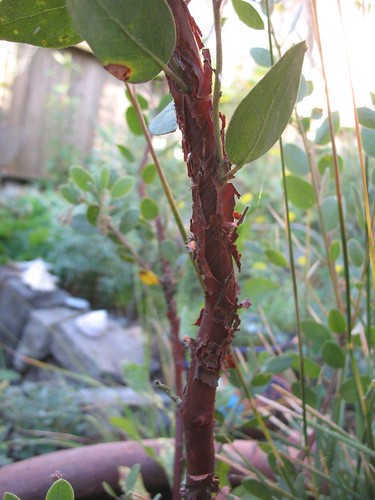
Exfoliating bark is one of my absolute favorite features in a plant. I'm not happy with a garden unless it's got some exfoliating bark. To that end, I also have Hydrangea petiolaris which shows off its exfoliating bark during winter dormancy.

In front of it in that shot, you see a containerized Fuchsia boliviana 'Alba' that I grew from seed. I have three of them in my garden, and here it is on the right with that dark taro, Colocasia escuelenta 'Illustris' which I keep in a half-sunk clay pot so it can stay moist while everything else around it remains on the dry side. The 'Alba' is remarkably happy with summer drought.

I bought that taro a couple years ago, and it's moved around the garden quite a bit. It got severely beaten down during a hailstorm last year, or maybe two years ago. It's been cut down to the ground, divided, and relocated so many times. But just a few months ago, I put some of it here where it will stay. (Anyhow, that's why it's small. I'll be three feet next year (unless it suffers more hail damage.
All this is happening right next to a young tree fern, which has potted Cymbidium around it.

That frame and mirror survived the garage sale separately. Afterwards, I put them together and moved them to the garden. In real life, it reflects the fern fronds better than it does in the picture.
Also surviving the garage sale, this painted leaf from India

that I hung on the back stairs.

The big-leafed aster is Bartlettina sordida

And, underneath, I want to give a shout out to this Plectranthus.

This plant rocks my world with it's white leaf margins. I'm convinced nothing else would work here quite as well as this plant. The leaf margins brings light to a dark corner, and the rough leaf texture complements the Bartlettina. Plus, it's super-easy to root and spreads by layering.
I dug up this Abutilon several months ago, and found it a home in a container in the back corner. In time it should fill in the corner nicely.

Companion plants for it in this corner include Philadelphus lewisii, Acer circinatum, and eventually, that Hydrangea petiolaris I showed you above. Plus, the Digitalis 'Apricot Beauty' will provide a color accent next spring.
Also, over here in this corner, I put western native Heracleum lanatum (Cow Parsnip).

If you want bold, coarse texture for part-sun with little supplemental water, give cow parsnip a whirl.
The bird bath garden, as some commenters called it, is keepin' on.

Hummingbirds love snowberry flowers, and it's already got some big, snowy berries.
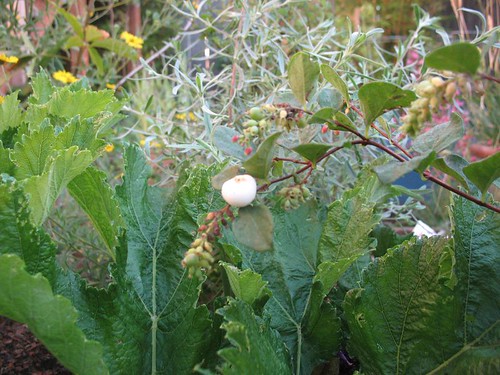
And I don't just grow tiny tomatoes.

And my 45-day cukes are doing well.

Although I have to promise never go try making trellises from bamboo and twine ever again. I keep thinking I'm going to get this right one day, but it always looks like crap.

The Echium wildprettii promises great things in store for next year.

And, of course, the Princess Plant.

Here are some of the things that are going right.
I think I'm doing a good job of getting a real California vibe.

A friend who works at Living Green gave me that big pot last year, for which I am eternally grateful. In it, I put Arctostaphylos bakeri 'Louis Edmunds' a popular garden cultivar of California's signature native shrub, the manzanita. It should grow into a small tree. Besides the winter flowers, my favorite part is the red wood and exfoliating bark.

Exfoliating bark is one of my absolute favorite features in a plant. I'm not happy with a garden unless it's got some exfoliating bark. To that end, I also have Hydrangea petiolaris which shows off its exfoliating bark during winter dormancy.

In front of it in that shot, you see a containerized Fuchsia boliviana 'Alba' that I grew from seed. I have three of them in my garden, and here it is on the right with that dark taro, Colocasia escuelenta 'Illustris' which I keep in a half-sunk clay pot so it can stay moist while everything else around it remains on the dry side. The 'Alba' is remarkably happy with summer drought.

I bought that taro a couple years ago, and it's moved around the garden quite a bit. It got severely beaten down during a hailstorm last year, or maybe two years ago. It's been cut down to the ground, divided, and relocated so many times. But just a few months ago, I put some of it here where it will stay. (Anyhow, that's why it's small. I'll be three feet next year (unless it suffers more hail damage.
All this is happening right next to a young tree fern, which has potted Cymbidium around it.

That frame and mirror survived the garage sale separately. Afterwards, I put them together and moved them to the garden. In real life, it reflects the fern fronds better than it does in the picture.
Also surviving the garage sale, this painted leaf from India

that I hung on the back stairs.

The big-leafed aster is Bartlettina sordida

And, underneath, I want to give a shout out to this Plectranthus.

This plant rocks my world with it's white leaf margins. I'm convinced nothing else would work here quite as well as this plant. The leaf margins brings light to a dark corner, and the rough leaf texture complements the Bartlettina. Plus, it's super-easy to root and spreads by layering.
I dug up this Abutilon several months ago, and found it a home in a container in the back corner. In time it should fill in the corner nicely.

Companion plants for it in this corner include Philadelphus lewisii, Acer circinatum, and eventually, that Hydrangea petiolaris I showed you above. Plus, the Digitalis 'Apricot Beauty' will provide a color accent next spring.
Also, over here in this corner, I put western native Heracleum lanatum (Cow Parsnip).

If you want bold, coarse texture for part-sun with little supplemental water, give cow parsnip a whirl.
The bird bath garden, as some commenters called it, is keepin' on.

Hummingbirds love snowberry flowers, and it's already got some big, snowy berries.

And I don't just grow tiny tomatoes.

And my 45-day cukes are doing well.

Although I have to promise never go try making trellises from bamboo and twine ever again. I keep thinking I'm going to get this right one day, but it always looks like crap.

The Echium wildprettii promises great things in store for next year.

And, of course, the Princess Plant.

Speaking of mugshots...
"I reached down and scooted over and the next thing I knew, under the bathroom divider comes a card that says 'police.'" Link.
Yeah, right.
Well, it's a cop's word against a senator's now.
Yeah, right.
Well, it's a cop's word against a senator's now.
8/29/2007
And another garden post!
I became serious about gardening after I lost my job in January 2006. Since that time, the garden has been in non-stop transition while I try to figure out how to make it work.
I feel like most of the garden has settled in to its final design and now everything just needs to grow. Except for this bed at the back. This is the one area I think still calls for serious reconsideration.
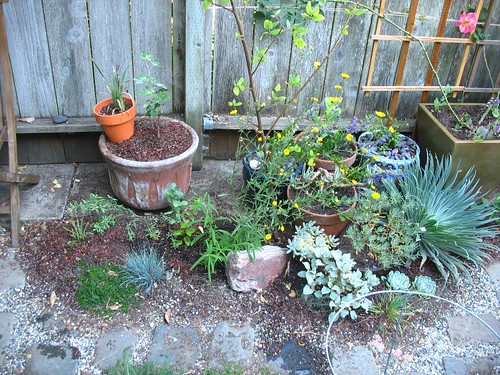
This bed first came into existence sometime last February, a month or so after I finished the cobblestone path that circles the CA native bed. It appeared on the blog for the first time in prelude in that month's disturbingly Blue post. (This post is actually kind of blue, so I'll try to keep it short.)
I've used this area to dump a lot of stuff I didn't know what else to do with. Let's examine the individual elements.
First of all, I didn't get a good picture of the Ceanothus 'Ray Hartman', but it's the tall plant belonging to the thin trunk climbing up off the top of the picture. It just doesn't seem to be doing very well. It lived in a container for several months before I planted it here, and I think it hates me for doing that. It might have to go. But I do feel that Ray Hartman belongs in this bed, and I may just replace him with a fresh specimen. So there's that.
But what else.
Well, there's this disturbingly monochromatic gray thing going on.

Yet another Echium wildprettii. I have four of these, ladies and gentlemen. I used to have five! There's no excuse for this situation. What can I say? I got swept up in one of my periodic flaming homosexual-themed decorating rampages.

You who garden outside of the mediterranean climate zone might not recognize this plant now for the phallic, path-obscuring monstrosity it will become next year when the inflorescence comes. (Pun intended.) Should I pull it, and enjoy three?
I have three of these too--Eriogonum arborescens (Polygonaceae). I grew this from seed. (So what, I grew the Echium from seed too.) This one doesn't look as good as the other two, but I think it'll be fine. I feel a strong desire to keep this plant based on what it brings to the garden and how it works in relation to the other two E. arborescens.
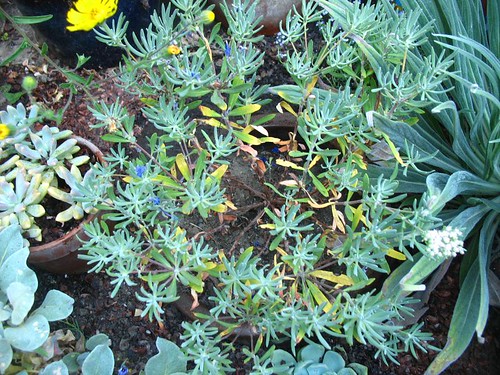
This is Eriogonum latifolium, coast buckwheat. (I think that's right; I'm kind of spacing right now.) This can stay in the garden, but it can't stay here.

I have another one right across the path, in bloom. Or post-bloom. It looks like this:

This is a good native for this area, and bees love it.
I have these succulents. These are cuttings I just stuck in the ground here; they don't need to stay at all.

I have five more I stuck in pots.

I could be happy keeping the five, and letting go of these two. Maybe I can give these two to someone else, or plant them around the community garden this fall. Or maybe they can go up on the roof.
Finally, closing out the gray zone, this succulent:

This plant is only gray right now. I wish I could remember the name of this plant, because I'd like to recommend it to you. But I have a terrible time with succulent names for some reason. Anyway, this plant goes through a range of color changes depending on water, sun exposure, and season. It's actually purple-yellow when it's happy. I don't know why it's not happy. It's probably the soil.
Anyway, this plant's in a pot and I can improve the situation with this plant by moving it about two feet over.

Yeah. I'll plant that in the ground tomorrow, and call it good. (That red flower--I forgot the name--is another one of the three I saw in the "paid-for" area at my nursery. The third and final plant I bought like that is this rosy pink and orange number; isn't it pretty? I think it is.)

Also back here, currently my bitterest garden disappointment, Vaccinium 'Top Hat'. This is a dwarf blueberry I've had all year. It's growing in acidic azalea mix. It should be much happier than this. I'm very disappointed. Should I just give up on this plant, or wait a year?

One of the dozen Cerinthe major volunteers that came up recently. It's growing at an alarming rate, and if it keeps up I could have flowers in a couple weeks. I'm quite amazed.

Super-fragrant and bee-beloved, this is CA native Trichostema lanatum, Wooly Blue Curls.
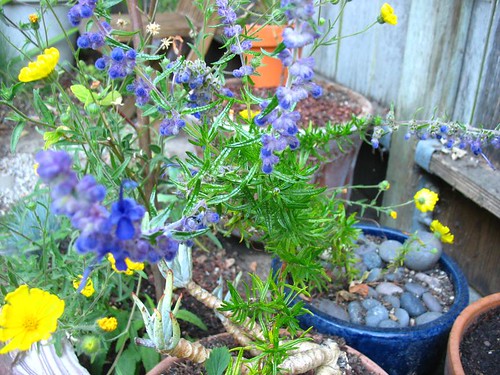
I enjoy this species but this specimen has grown weirdly and it's hard to feature. Perhaps I should prune it somehow... I'm told planting it in the ground is risky in San Francisco--but I could take that risk with this plant since it's already kind of a mess. I don't know.

Cotyledon orbiculatum var. longifolium. I planted this cutting the last time I was stoned, whenever that was.

Previously, this plant was in a box on my front porch and it was growing over the box and trailing into the path of people using the front steps. So I cut it, and stuck it in this pot straight up thinking it would be groovy and unusual when it started making new growth at the tips. I never would have thought of that sober. I still think it will work out, but here I've moved it to a shady area to root. (I put the strawberry in the other day to fill up some empty space while the cutting roots.)
Yet more Cerinthe... it self-sowed vigorously. Seriously, I have about 20 of these.

Keckiella cordifolia. I grew these for the Botanical Garden, and kept a few for myself. I have no idea what to expect from this plant.

I'm so tired of this blue grass. I have five of them from divisions.

I started sticking thyme here and there to cover all the dirt. I see no reason to remove thyme.

Speaking of thyme, have you read these books?

I picked it up off the sidewalk on my way to the bank after the garage sale. (Lots of people who couldn't get money for their stuff left it all out on the sidewalk for people to pick through for free.) Anyhoo, it's from a series about a former attorney who opens an herb shop in lovely Pecan Springs, Texas. Naturally, she gets drawn in to botanically inflected murder mysteries that she uses her lawyering skills to solve. What's not to love.
But this post isn't about books, it's about my problems.
Back to my problems.
I have this mangy Lessingia I recently tipped way back to encourage new growth from the base...

A blurry Epilobium...

And a blurry and mangy Salvia spathacea (new from seed this year).

The vine is Ampelopsis brevipedunculata which I'd heard is a fabulous plant (where it's not invasive) and I found on clearance late last year. I've had to cut this one way back because it was all enmeshed in the tomatoes I removed in the last post.
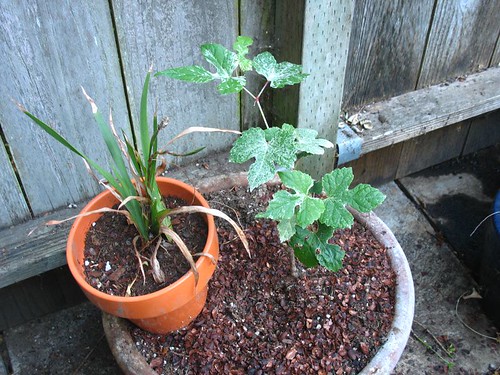
And finally, I have the annual Madia (not a problem; it's an annual) and this rock which I bought on impulse at the stoneyard one day last year. Actually, I bought three of them. I ended up giving one to my dad. Maybe I should give him the other two.

And that's where this post ends. Seriously. I hope you weren't expecting me to have this all fixed by the end of the post..? Rome wasn't built in a day, people! I have to think about this for awhile.
(I do apologize that everything is so blue. I should know better than to take pictures late in the day like this. The light is just all wrong.)
I feel like most of the garden has settled in to its final design and now everything just needs to grow. Except for this bed at the back. This is the one area I think still calls for serious reconsideration.

This bed first came into existence sometime last February, a month or so after I finished the cobblestone path that circles the CA native bed. It appeared on the blog for the first time in prelude in that month's disturbingly Blue post. (This post is actually kind of blue, so I'll try to keep it short.)
I've used this area to dump a lot of stuff I didn't know what else to do with. Let's examine the individual elements.
First of all, I didn't get a good picture of the Ceanothus 'Ray Hartman', but it's the tall plant belonging to the thin trunk climbing up off the top of the picture. It just doesn't seem to be doing very well. It lived in a container for several months before I planted it here, and I think it hates me for doing that. It might have to go. But I do feel that Ray Hartman belongs in this bed, and I may just replace him with a fresh specimen. So there's that.
But what else.
Well, there's this disturbingly monochromatic gray thing going on.

Yet another Echium wildprettii. I have four of these, ladies and gentlemen. I used to have five! There's no excuse for this situation. What can I say? I got swept up in one of my periodic flaming homosexual-themed decorating rampages.

You who garden outside of the mediterranean climate zone might not recognize this plant now for the phallic, path-obscuring monstrosity it will become next year when the inflorescence comes. (Pun intended.) Should I pull it, and enjoy three?
I have three of these too--Eriogonum arborescens (Polygonaceae). I grew this from seed. (So what, I grew the Echium from seed too.) This one doesn't look as good as the other two, but I think it'll be fine. I feel a strong desire to keep this plant based on what it brings to the garden and how it works in relation to the other two E. arborescens.

This is Eriogonum latifolium, coast buckwheat. (I think that's right; I'm kind of spacing right now.) This can stay in the garden, but it can't stay here.

I have another one right across the path, in bloom. Or post-bloom. It looks like this:

This is a good native for this area, and bees love it.
I have these succulents. These are cuttings I just stuck in the ground here; they don't need to stay at all.

I have five more I stuck in pots.

I could be happy keeping the five, and letting go of these two. Maybe I can give these two to someone else, or plant them around the community garden this fall. Or maybe they can go up on the roof.
Finally, closing out the gray zone, this succulent:

This plant is only gray right now. I wish I could remember the name of this plant, because I'd like to recommend it to you. But I have a terrible time with succulent names for some reason. Anyway, this plant goes through a range of color changes depending on water, sun exposure, and season. It's actually purple-yellow when it's happy. I don't know why it's not happy. It's probably the soil.
Anyway, this plant's in a pot and I can improve the situation with this plant by moving it about two feet over.

Yeah. I'll plant that in the ground tomorrow, and call it good. (That red flower--I forgot the name--is another one of the three I saw in the "paid-for" area at my nursery. The third and final plant I bought like that is this rosy pink and orange number; isn't it pretty? I think it is.)

Also back here, currently my bitterest garden disappointment, Vaccinium 'Top Hat'. This is a dwarf blueberry I've had all year. It's growing in acidic azalea mix. It should be much happier than this. I'm very disappointed. Should I just give up on this plant, or wait a year?

One of the dozen Cerinthe major volunteers that came up recently. It's growing at an alarming rate, and if it keeps up I could have flowers in a couple weeks. I'm quite amazed.

Super-fragrant and bee-beloved, this is CA native Trichostema lanatum, Wooly Blue Curls.

I enjoy this species but this specimen has grown weirdly and it's hard to feature. Perhaps I should prune it somehow... I'm told planting it in the ground is risky in San Francisco--but I could take that risk with this plant since it's already kind of a mess. I don't know.

Cotyledon orbiculatum var. longifolium. I planted this cutting the last time I was stoned, whenever that was.

Previously, this plant was in a box on my front porch and it was growing over the box and trailing into the path of people using the front steps. So I cut it, and stuck it in this pot straight up thinking it would be groovy and unusual when it started making new growth at the tips. I never would have thought of that sober. I still think it will work out, but here I've moved it to a shady area to root. (I put the strawberry in the other day to fill up some empty space while the cutting roots.)
Yet more Cerinthe... it self-sowed vigorously. Seriously, I have about 20 of these.

Keckiella cordifolia. I grew these for the Botanical Garden, and kept a few for myself. I have no idea what to expect from this plant.

I'm so tired of this blue grass. I have five of them from divisions.

I started sticking thyme here and there to cover all the dirt. I see no reason to remove thyme.

Speaking of thyme, have you read these books?

I picked it up off the sidewalk on my way to the bank after the garage sale. (Lots of people who couldn't get money for their stuff left it all out on the sidewalk for people to pick through for free.) Anyhoo, it's from a series about a former attorney who opens an herb shop in lovely Pecan Springs, Texas. Naturally, she gets drawn in to botanically inflected murder mysteries that she uses her lawyering skills to solve. What's not to love.
But this post isn't about books, it's about my problems.
Back to my problems.
I have this mangy Lessingia I recently tipped way back to encourage new growth from the base...

A blurry Epilobium...

And a blurry and mangy Salvia spathacea (new from seed this year).

The vine is Ampelopsis brevipedunculata which I'd heard is a fabulous plant (where it's not invasive) and I found on clearance late last year. I've had to cut this one way back because it was all enmeshed in the tomatoes I removed in the last post.

And finally, I have the annual Madia (not a problem; it's an annual) and this rock which I bought on impulse at the stoneyard one day last year. Actually, I bought three of them. I ended up giving one to my dad. Maybe I should give him the other two.

And that's where this post ends. Seriously. I hope you weren't expecting me to have this all fixed by the end of the post..? Rome wasn't built in a day, people! I have to think about this for awhile.
(I do apologize that everything is so blue. I should know better than to take pictures late in the day like this. The light is just all wrong.)
How about a garden post for a change?
As much as I enjoy growing really small tomatoes, the vegetable garden (a tomato monoculture) has been keeping me up at night.
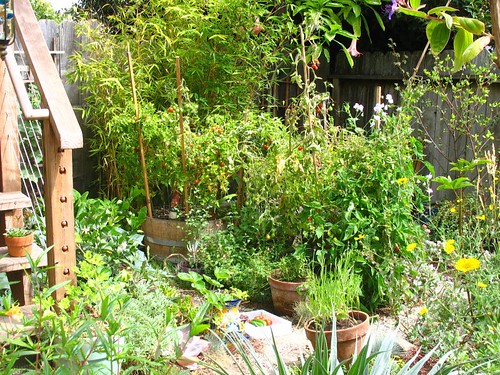
I have two half-barrels of tomato plants. The harvest started in mid-June, and I expect the season to run through October. But the plants are looking shabby (as in shabby, not shabby-chic). I'm glad I have two barrels, because the time has come for one of them to go.
I expected the roots to be more extensive than this.

I actually have a minor redesign in mind. I removed the Fremontodendron from the big blue container it hated, and I moved the container into the vegetable garden where I'll use it for vegetables--effectively a raised-bed without the trouble of bed-raising.

Also in that container was tough, small, native perennial mallow Sidalcea malviflora, common name Checkerbloom.
It spreads by long, deep runners like this.

Like all mallows, it's very difficult to dig up--much tougher than the shrubby Fremontodendron! But I have a whole bucket full of healthy checkerbloom divisions to distribute around the garden.

I'm also moving the garden path from here...

To here:
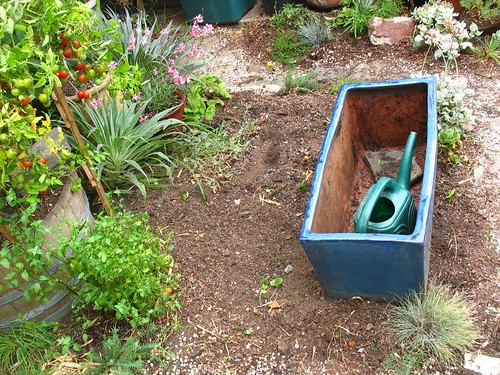
This will accomplish two things. First, making a circuit through the garden will now require a walk through the vegetable garden instead of around it. Second, it gives a manzanita you really can't see in this picture more room to grow. More on that later.

(The garden is still mostly soil! Next year...always next year...)
Removing one of the tomato barrels also revealed a previously obscured Echium wildprettii (the one on the left).

The Ficus carica 'Brown Turkey' is new to the garden. I bought that a couple weeks ago during a spontaneous, mid-week run up to California Flora after work. They had 1-gallon figs on clearance. My favorite way to shop.
This blue spires is new too. I've already forgotten what it is, but I'm sure you can tell me.

(The other day, I did something I've never done before. I checked out the back area of nursery I shop at most often to see what plants they were holding for local professionals. I liked three plants I saw back there that I never would have bought myself. The nursery more of them for sale, and I bought all three. Blue spires was one of those three--see the other two later.)
Another thing I did was remove my one remainging Datura wrightii. I think we've enjoyed this flower enough for 2007.

It's getting so big, I can't deal with it anymore. The coveted thorny seedball will have to wait until next year when I'll grow this plant in a container instead of in the ground. I'm changing it out for the Silver Bush Lupine I brought down from the roof garden.

I dressed up to extirpate the possibly quite poisonous (but probably not through simple skin contact) Jimson Weed.
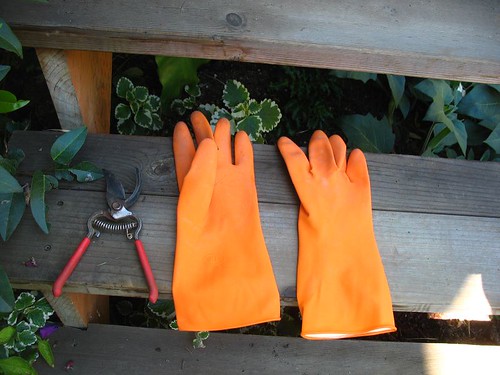
And I had to smash the pot with a hammer to get my hands on the lupine. So glad I put the lupine in a terracotta pot and not a nice glazed pot!

The lupine bookends the Meyer lemon with the silver/gray so common in California garden color schemes; the other bookend is native buckwheat Eriogonum arborescens.

The yellow flower behind it all is my new, naturally two-dimensional Fremontodendron 'San Gabriel' to replace the one I had to remove from the big blue container. I've waited to institute this plan for several months. So glad it's done!
Come back later for a little tour of the garden--right now, dinner's on!

I have two half-barrels of tomato plants. The harvest started in mid-June, and I expect the season to run through October. But the plants are looking shabby (as in shabby, not shabby-chic). I'm glad I have two barrels, because the time has come for one of them to go.
I expected the roots to be more extensive than this.

I actually have a minor redesign in mind. I removed the Fremontodendron from the big blue container it hated, and I moved the container into the vegetable garden where I'll use it for vegetables--effectively a raised-bed without the trouble of bed-raising.

Also in that container was tough, small, native perennial mallow Sidalcea malviflora, common name Checkerbloom.
It spreads by long, deep runners like this.

Like all mallows, it's very difficult to dig up--much tougher than the shrubby Fremontodendron! But I have a whole bucket full of healthy checkerbloom divisions to distribute around the garden.

I'm also moving the garden path from here...

To here:

This will accomplish two things. First, making a circuit through the garden will now require a walk through the vegetable garden instead of around it. Second, it gives a manzanita you really can't see in this picture more room to grow. More on that later.

(The garden is still mostly soil! Next year...always next year...)
Removing one of the tomato barrels also revealed a previously obscured Echium wildprettii (the one on the left).

The Ficus carica 'Brown Turkey' is new to the garden. I bought that a couple weeks ago during a spontaneous, mid-week run up to California Flora after work. They had 1-gallon figs on clearance. My favorite way to shop.
This blue spires is new too. I've already forgotten what it is, but I'm sure you can tell me.

(The other day, I did something I've never done before. I checked out the back area of nursery I shop at most often to see what plants they were holding for local professionals. I liked three plants I saw back there that I never would have bought myself. The nursery more of them for sale, and I bought all three. Blue spires was one of those three--see the other two later.)
Another thing I did was remove my one remainging Datura wrightii. I think we've enjoyed this flower enough for 2007.

It's getting so big, I can't deal with it anymore. The coveted thorny seedball will have to wait until next year when I'll grow this plant in a container instead of in the ground. I'm changing it out for the Silver Bush Lupine I brought down from the roof garden.

I dressed up to extirpate the possibly quite poisonous (but probably not through simple skin contact) Jimson Weed.

And I had to smash the pot with a hammer to get my hands on the lupine. So glad I put the lupine in a terracotta pot and not a nice glazed pot!

The lupine bookends the Meyer lemon with the silver/gray so common in California garden color schemes; the other bookend is native buckwheat Eriogonum arborescens.

The yellow flower behind it all is my new, naturally two-dimensional Fremontodendron 'San Gabriel' to replace the one I had to remove from the big blue container. I've waited to institute this plan for several months. So glad it's done!
Come back later for a little tour of the garden--right now, dinner's on!
Subscribe to:
Comments (Atom)
